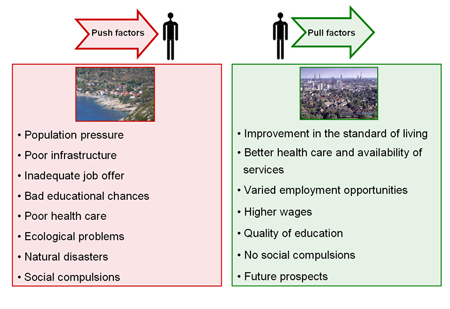2. Urbanisation
Why people move
In-migration, natural population increase and administrative reclassification of urban areas are the three main sources of urban population growth today. Most urban growth comes from natural increase rather than migration with poor people making up a large part in developing regions (UNFPA 2008, UN-HABITAT 2001, Pacione 2001).
Migration is not a single process but a complex human response to changing local circumstances within a global economic system mostly fueled by economic reasons (see table).
Reasons for migration from rural North-East Thailand
| Principal reasons | Percentage of respondents citing reason |
| To earn more money for the household | 52.9 |
| To earn more money for self | 21.8 |
| To earn more money for parents | 11.9 |
| To further education | 4.6 |
| To earn money to build a house | 3.8 |
| To earn money to invest in farming | 1.5 |
| For fun | 1.1 |
| To earn money to purchase land/land title | 0.8 |
| Other | 1.6 |
Source: Parnwell 1993, cited in Pacione 2001
Migration from the land into the cities (rural-urban mobility) is controlled by so-called push- and pull-factors. The permanent worsening of the living conditions in the country, the outlook on life and the wishes of the migrants (push-factors) as well as the expectations, especially for employment in the city (pull-factors) persuades the people to leave the rural, unattractive area and to accept the city as their home and workplace. Both factors are mutually dependent (see also figure).
Girls and young women have better educational and career opportunities in the cities of the developing countries. Unlike in the country, they get to know new technologies and are able to follow their own wishes. Consequently, they'll have less children, whereby the population growth in the cities can slow down and decrease (Latz 2007, Claaßen 2008).
The growth of cities in the Third World is additionally fueled by a high natural increase of urban population. The natural population growth in the cities is normally lower than in the country, since the people have better access to family planning and health care services. However, the supply of nutrition, education and accommodation is more difficult and expensive. The influx of people from rural areas need time to learn and adapt their lifestyle to an urban way of life. In the beginning, this process is slow and at least in the first generation, the number of children is high.
Push- and Pull-Factors

Own illustration
People are migrating from rural to urban areas because of very poor economic conditions in rural settlements rather than because of realistic prospects for jobs in the cities. Frequently, the hopes in the city are not fulfilled. The industry is not able to take in the immigrated workers, why the tertiary and the informal sector in the cities often are distinctively oversized. The people continue to migrate to cities in response to "pull" factors that are often more imaginary than real (Claaßen 2008, De Blij, Murphy 2003, Renwick, Rubenstein 1995).
Task: 1. Explain the push-pull-model. Give reasons why the expectations of the migrants are often not fulfilled.
